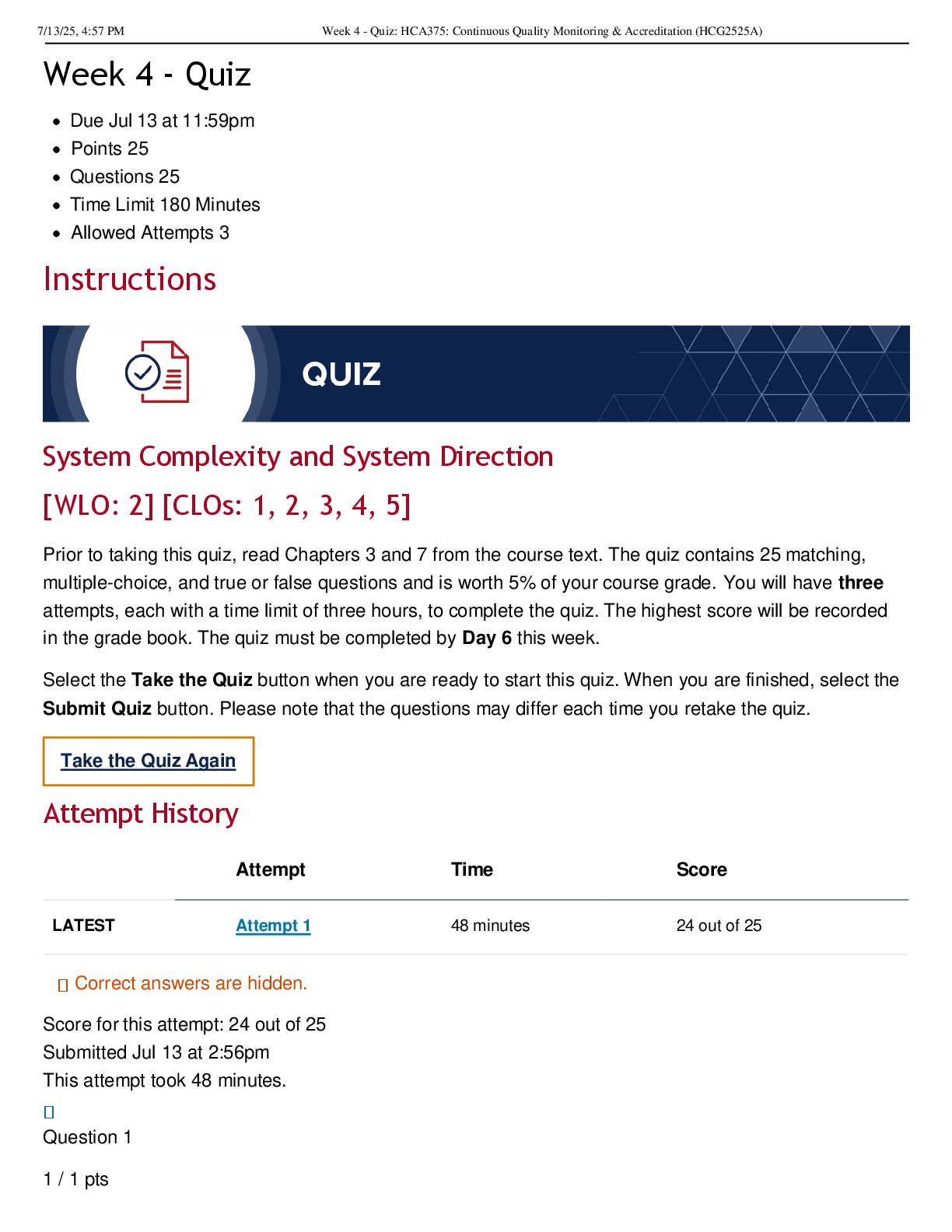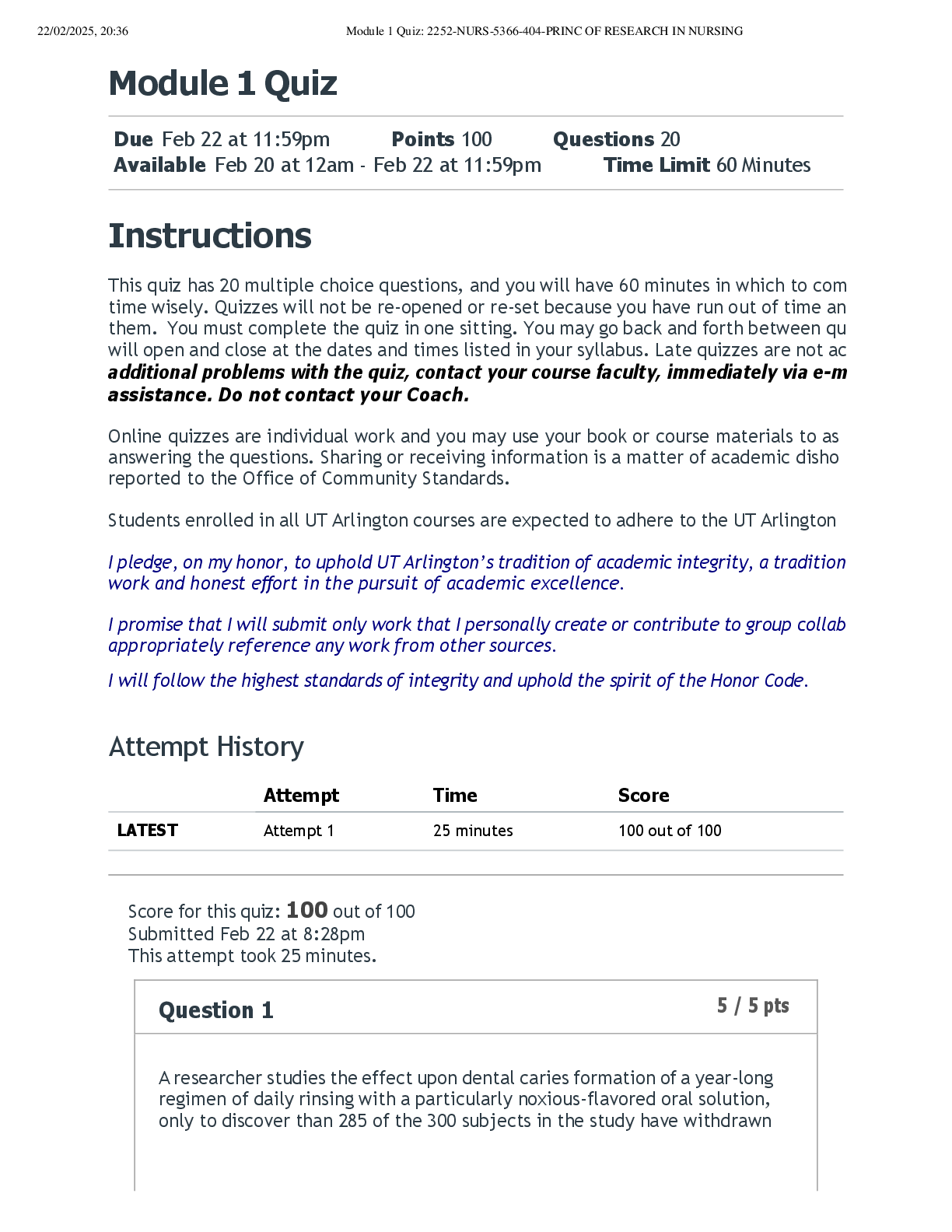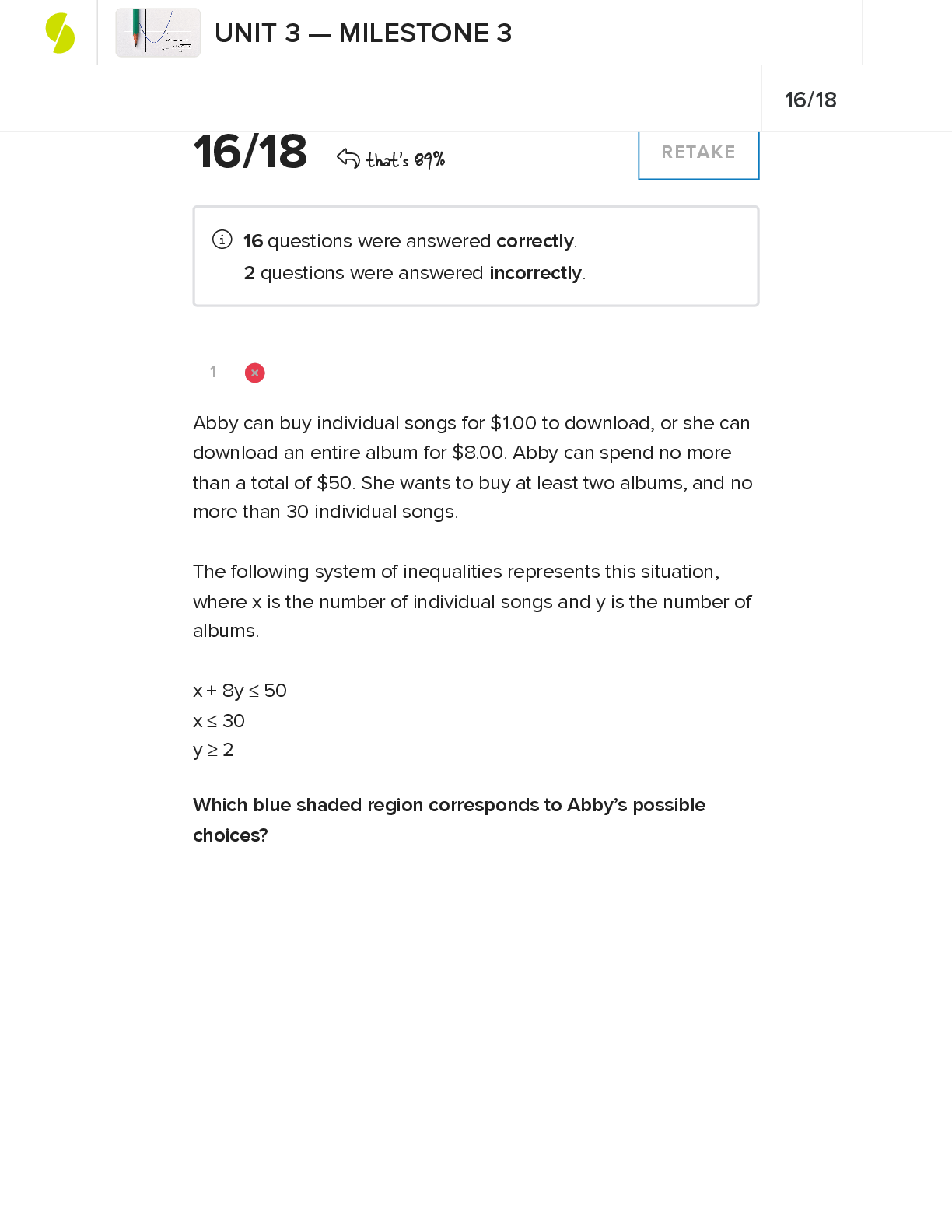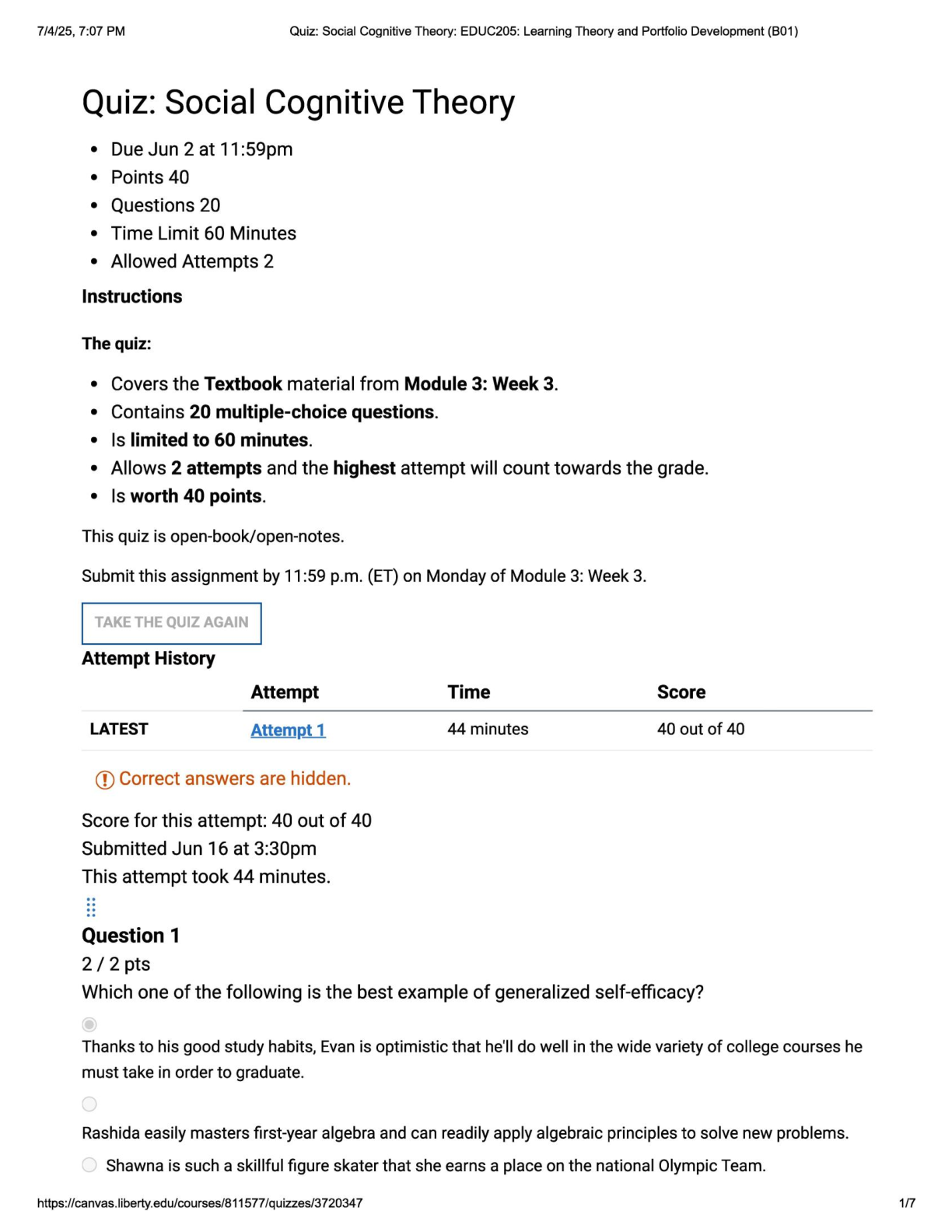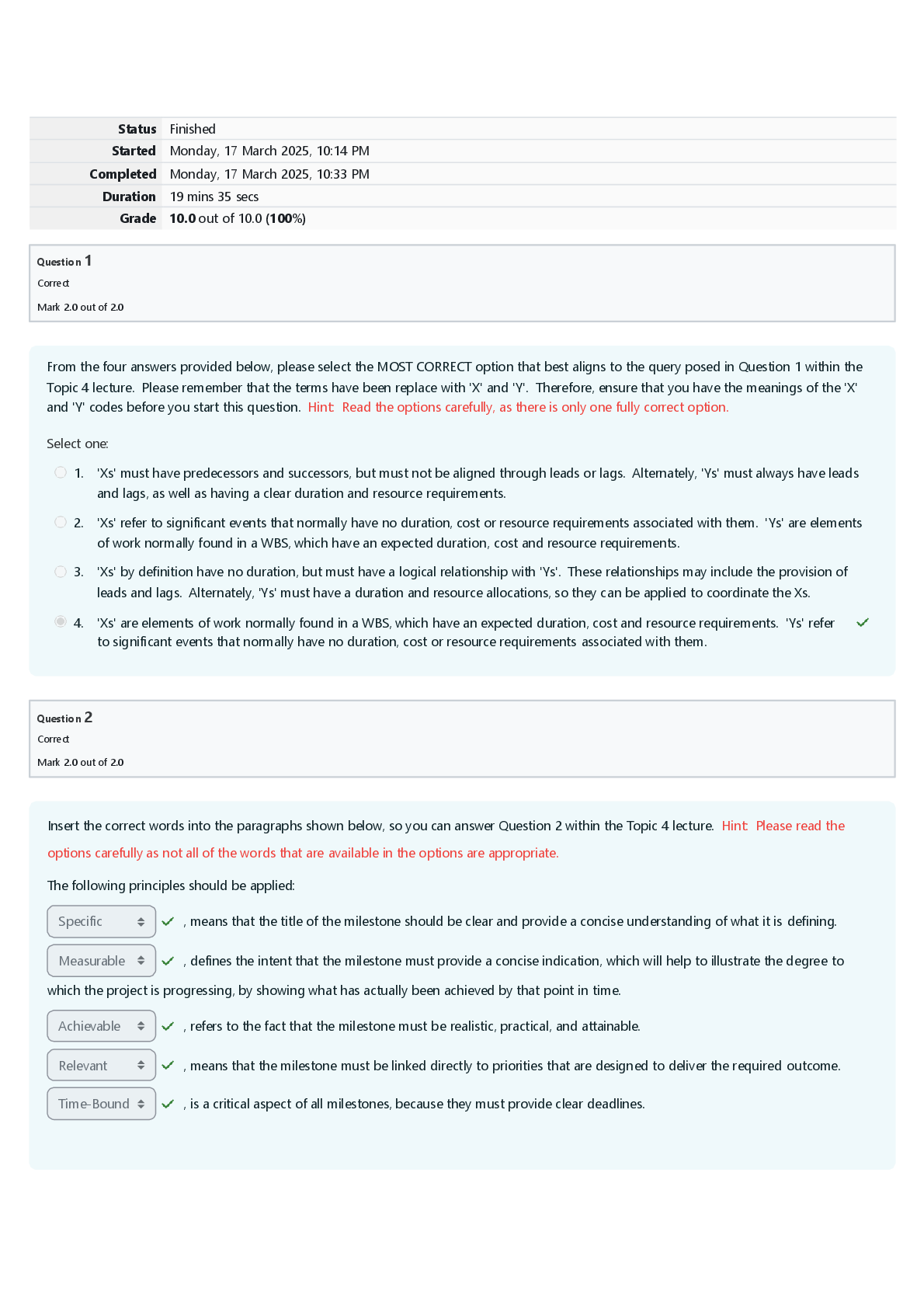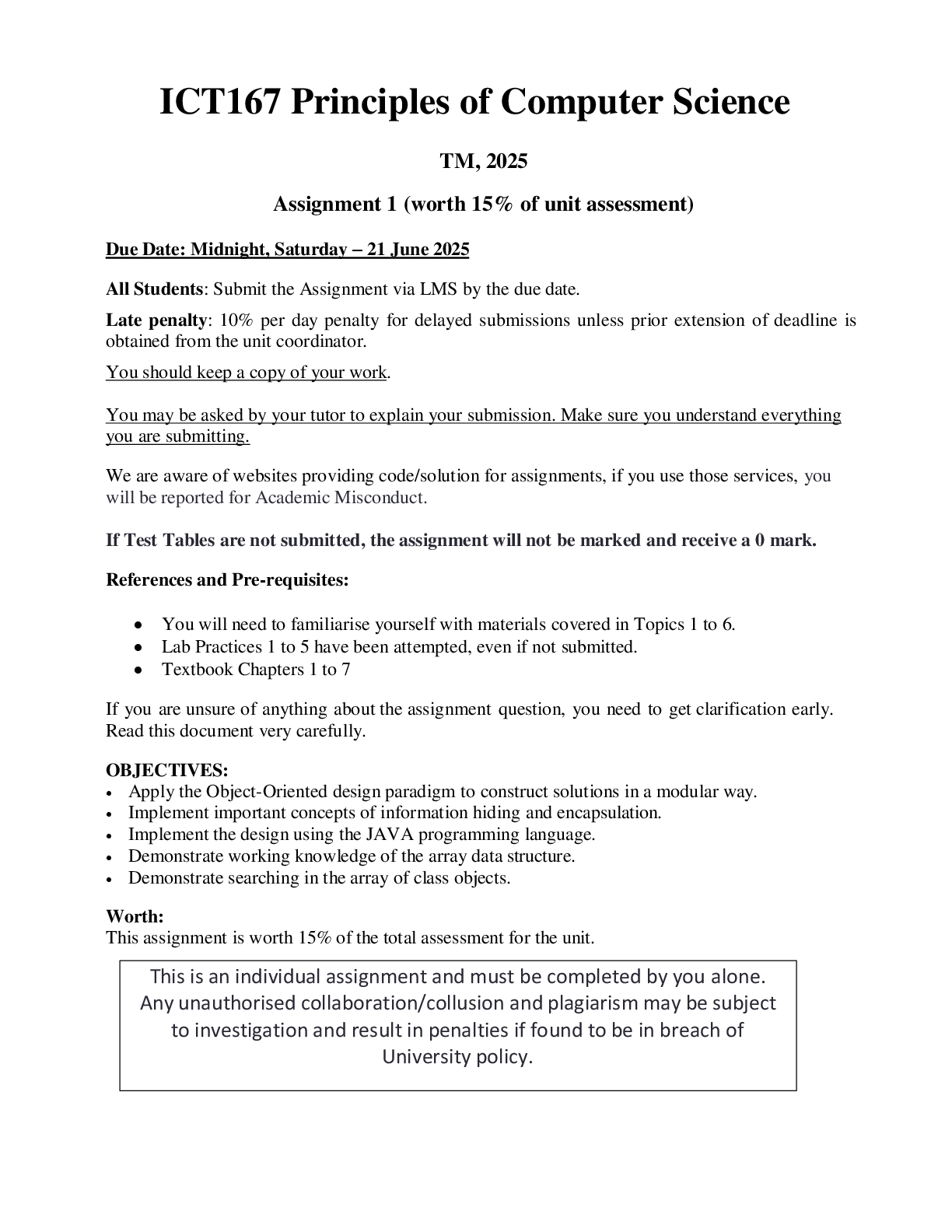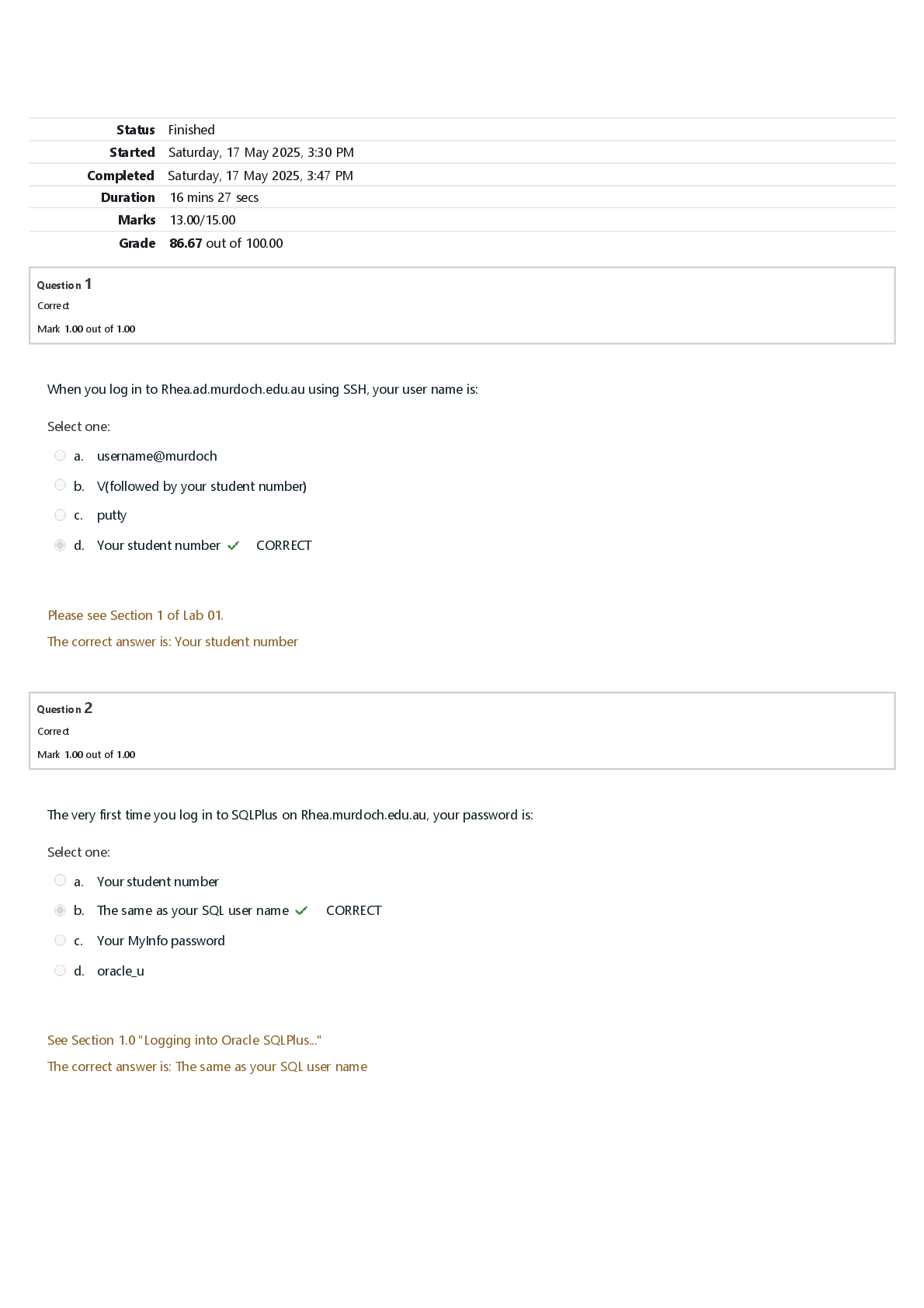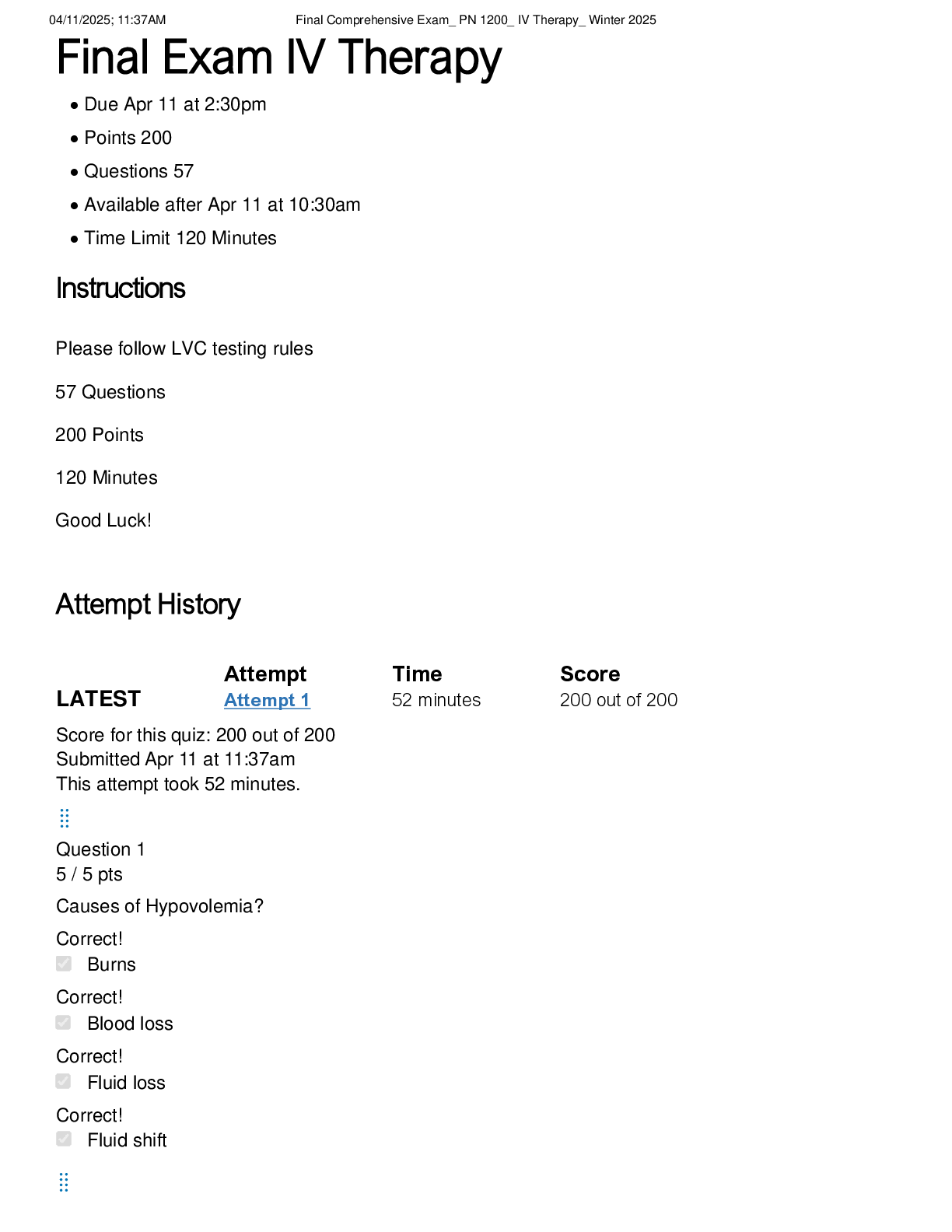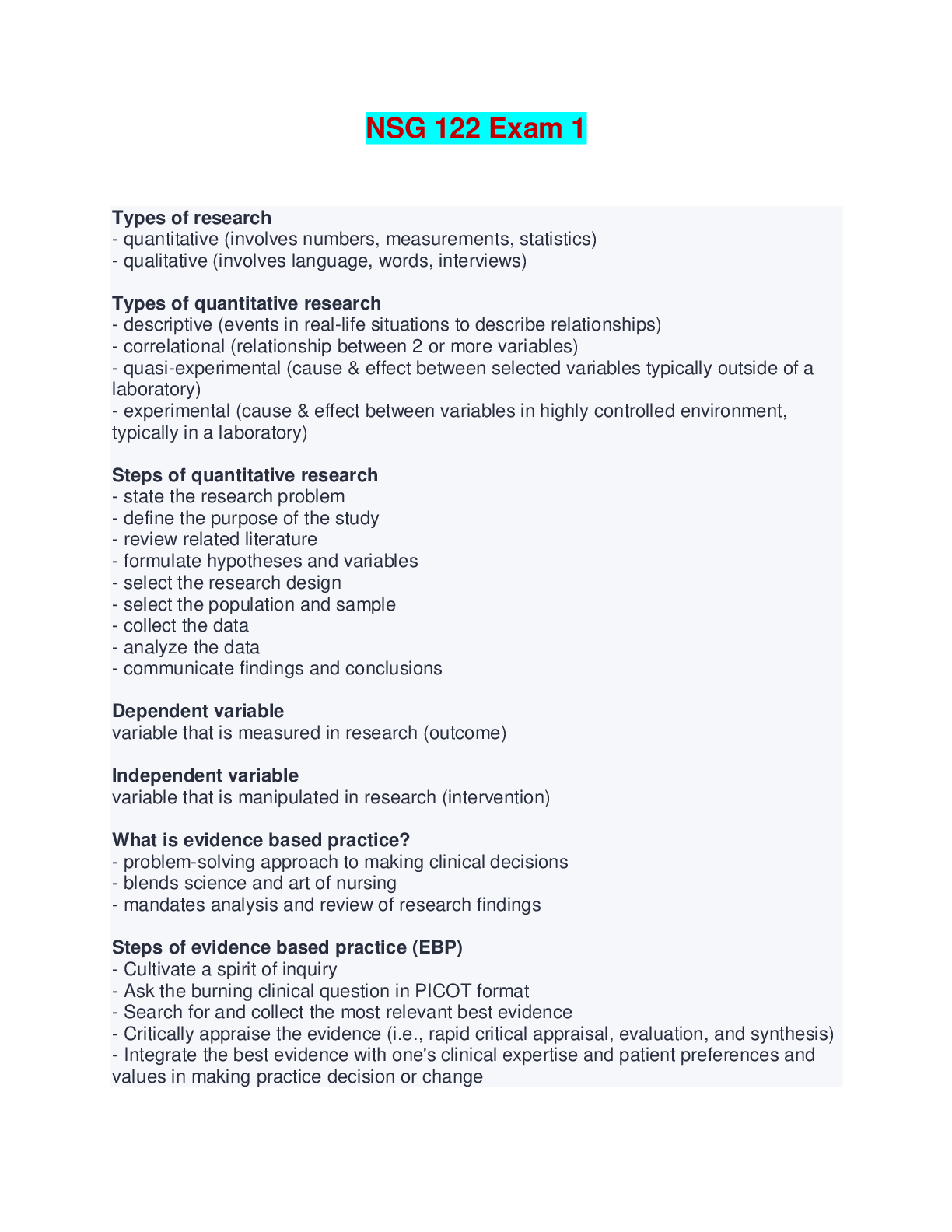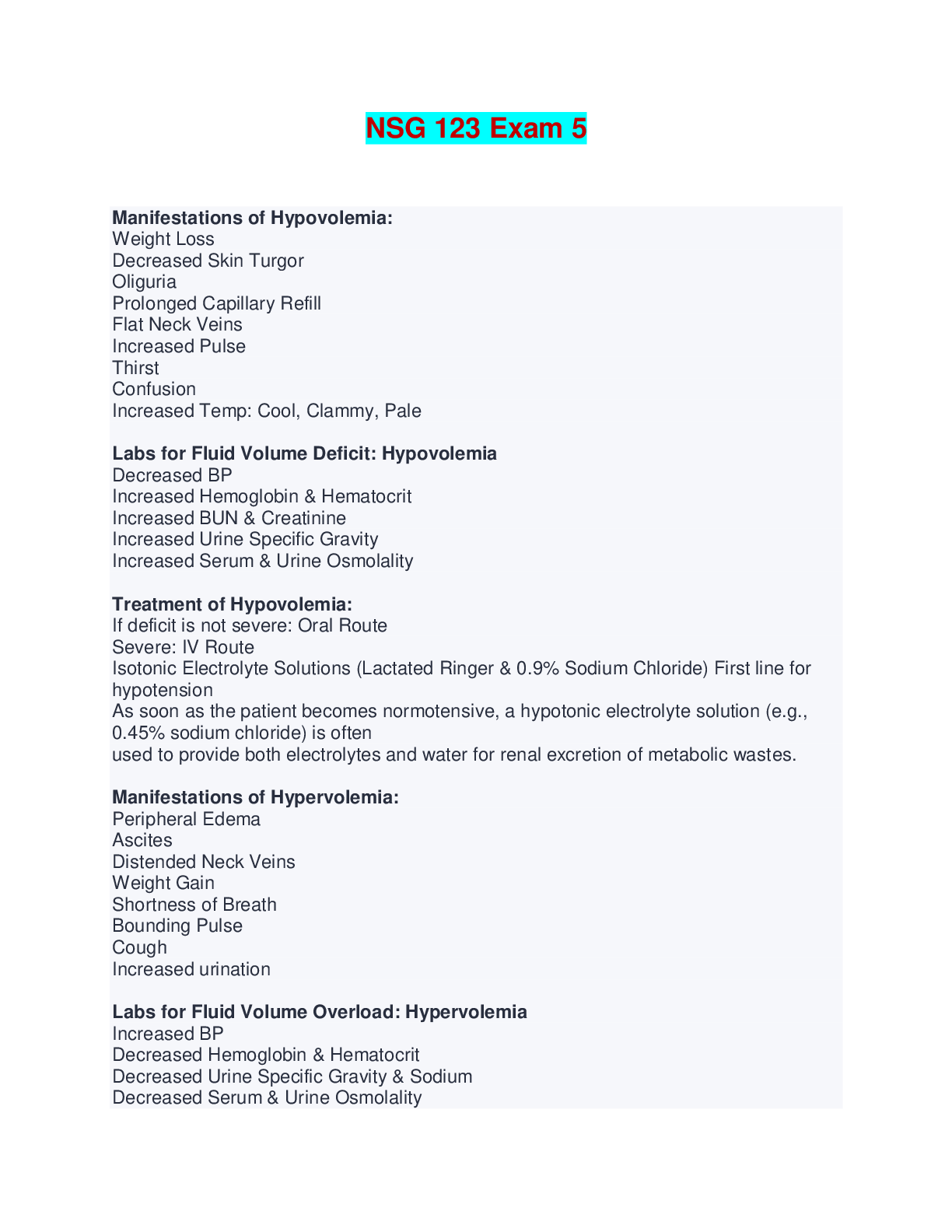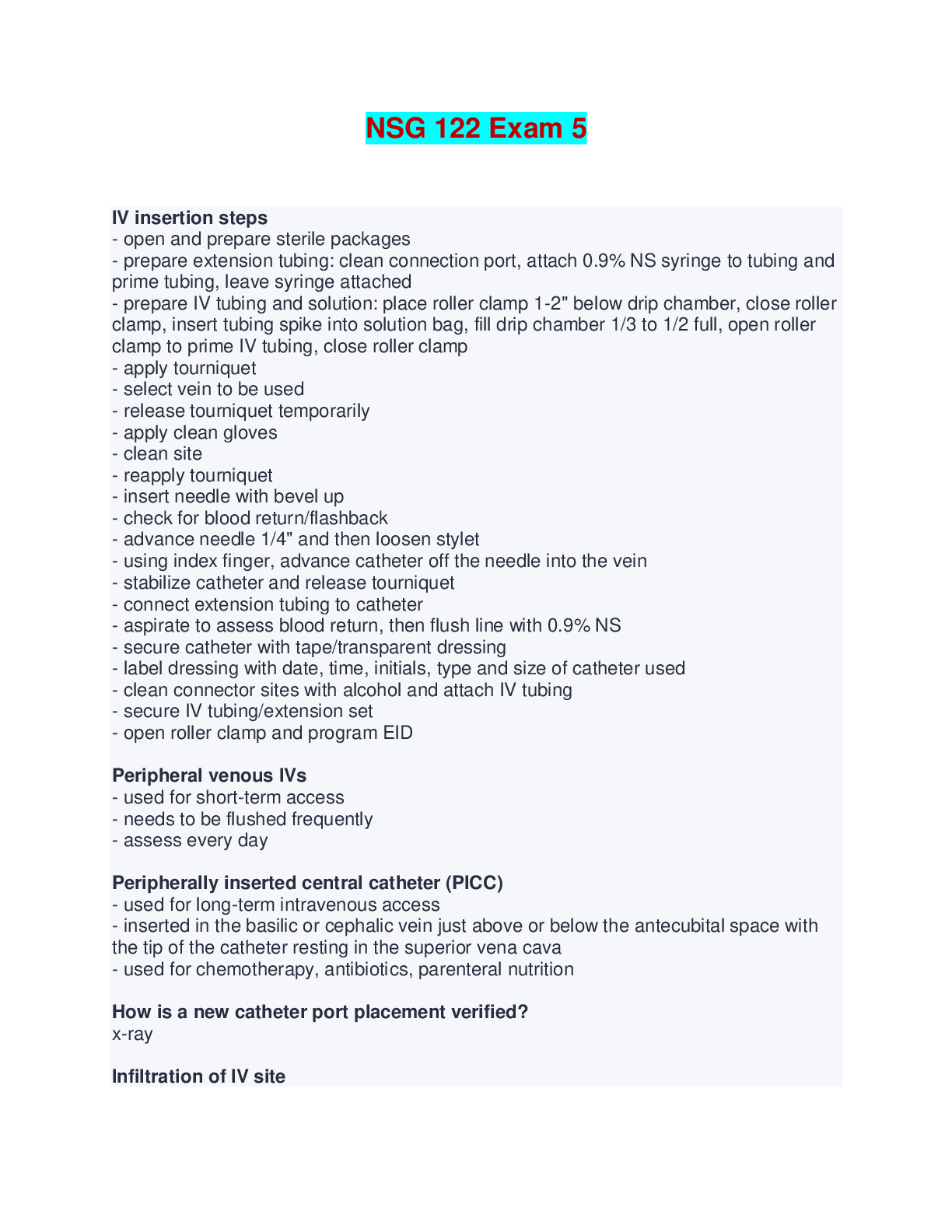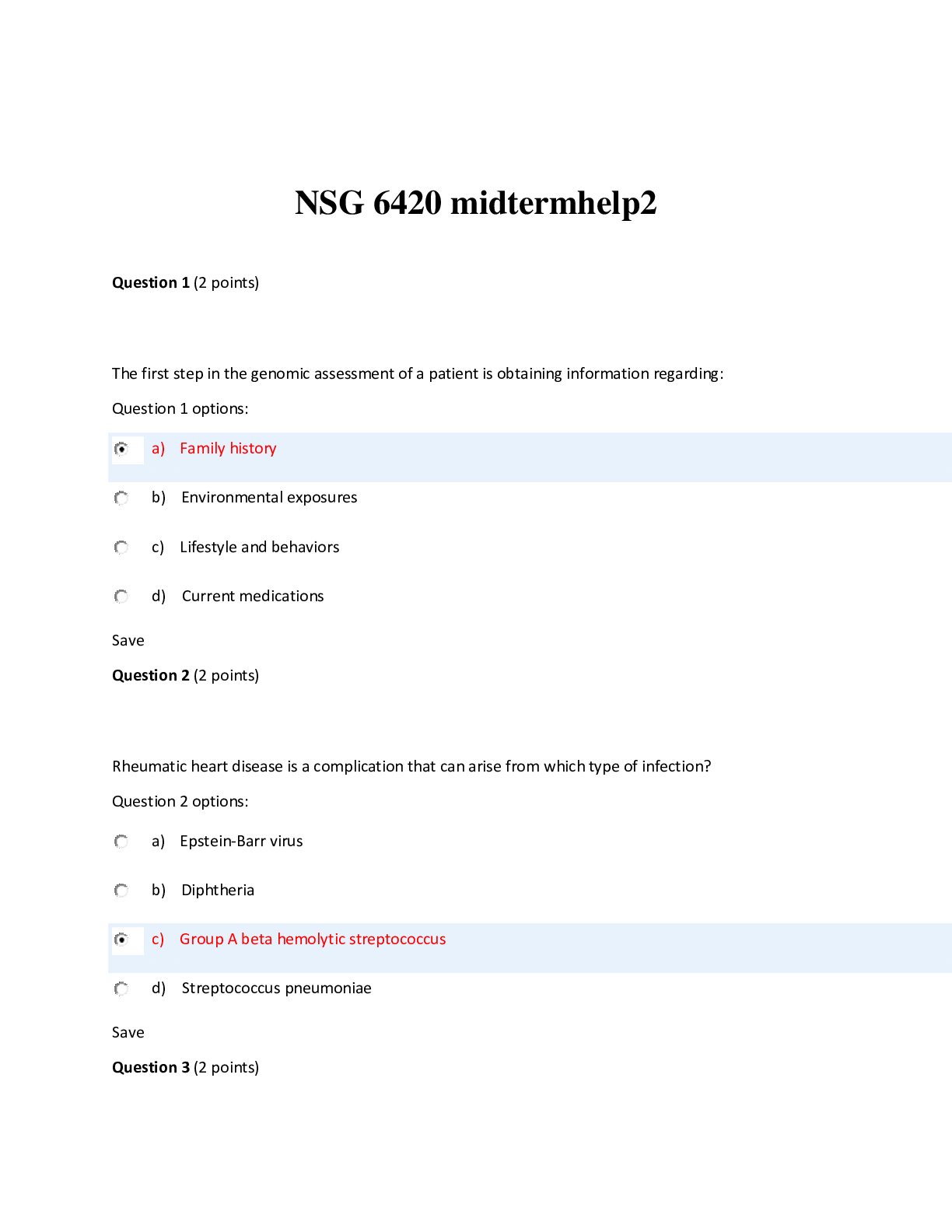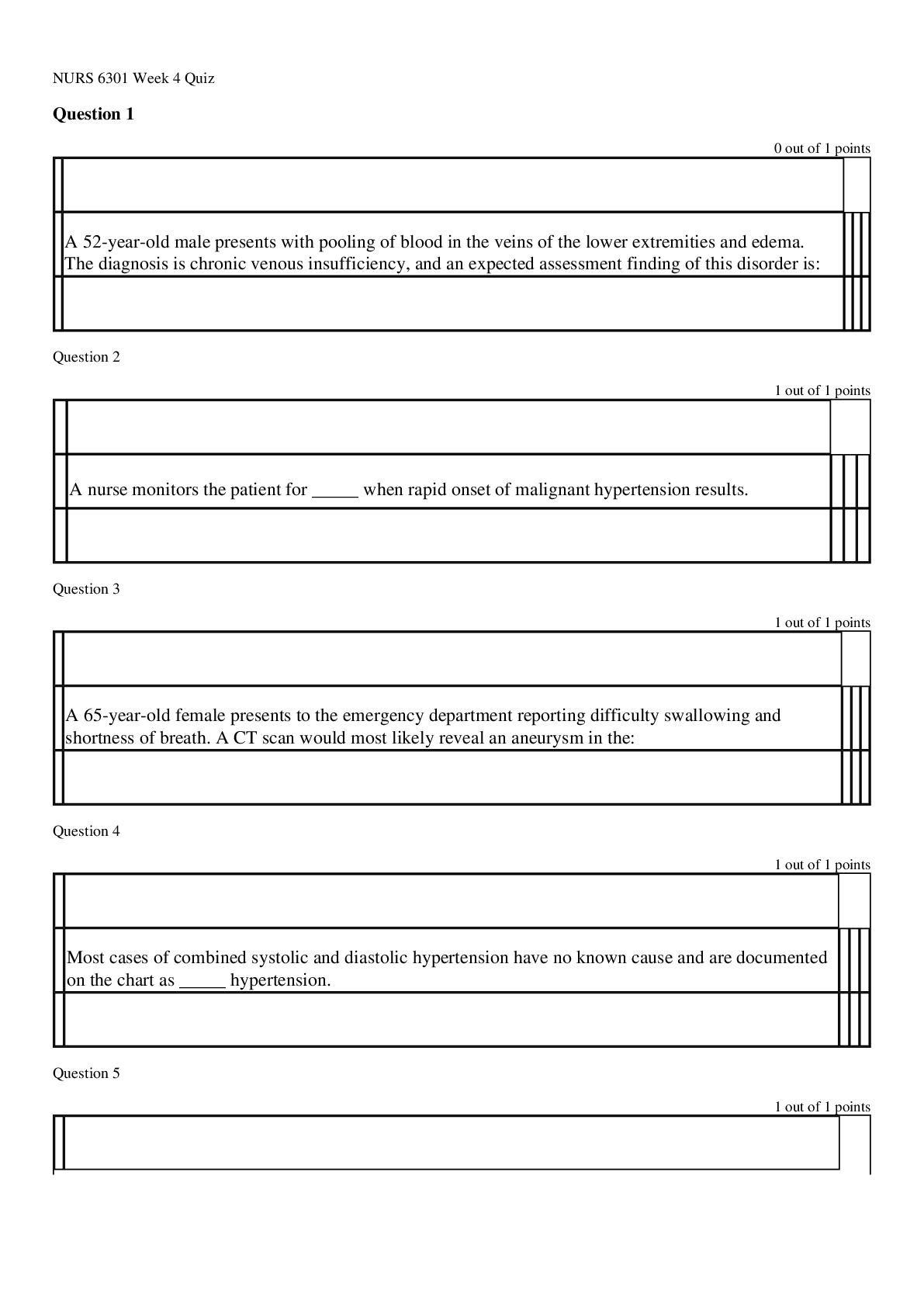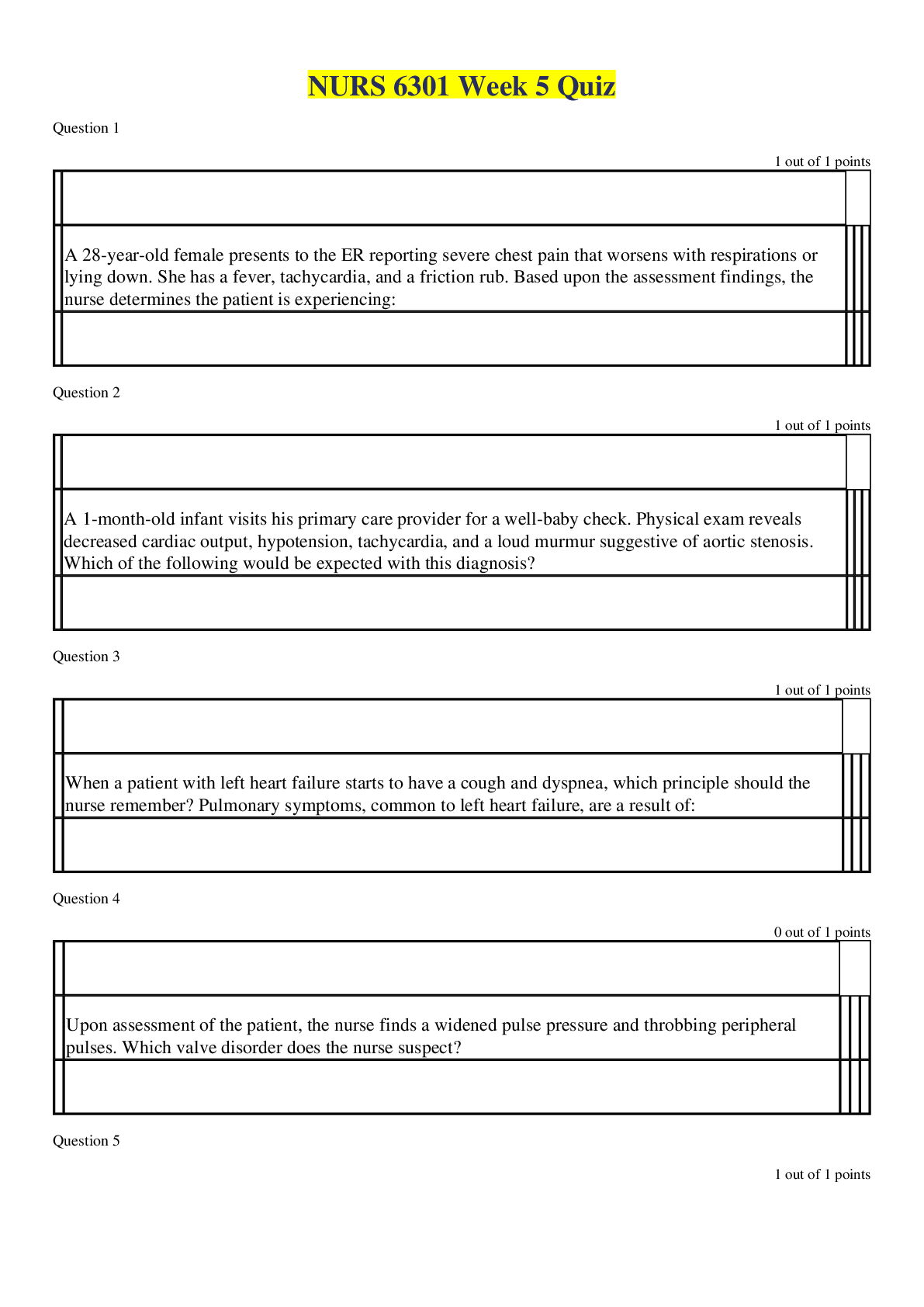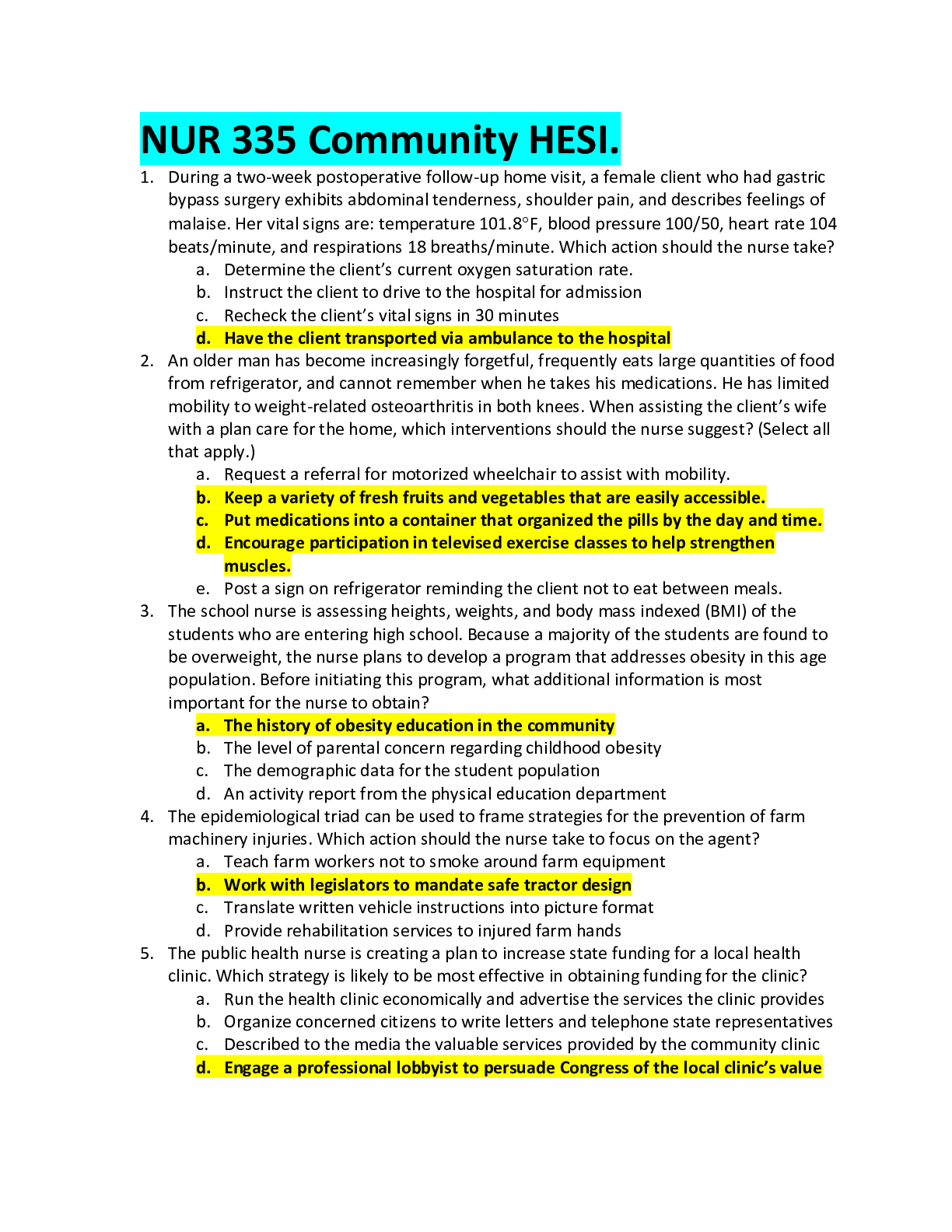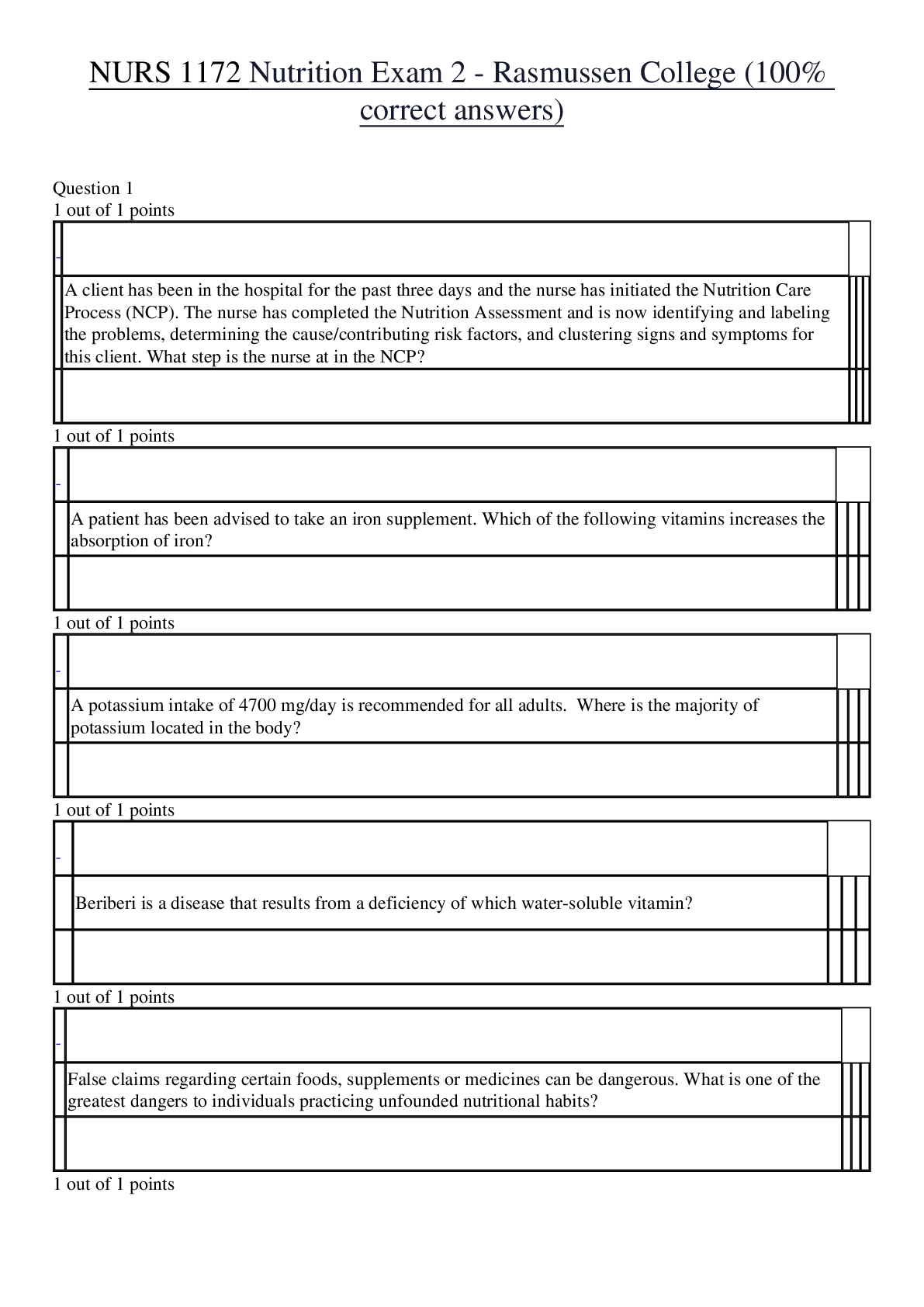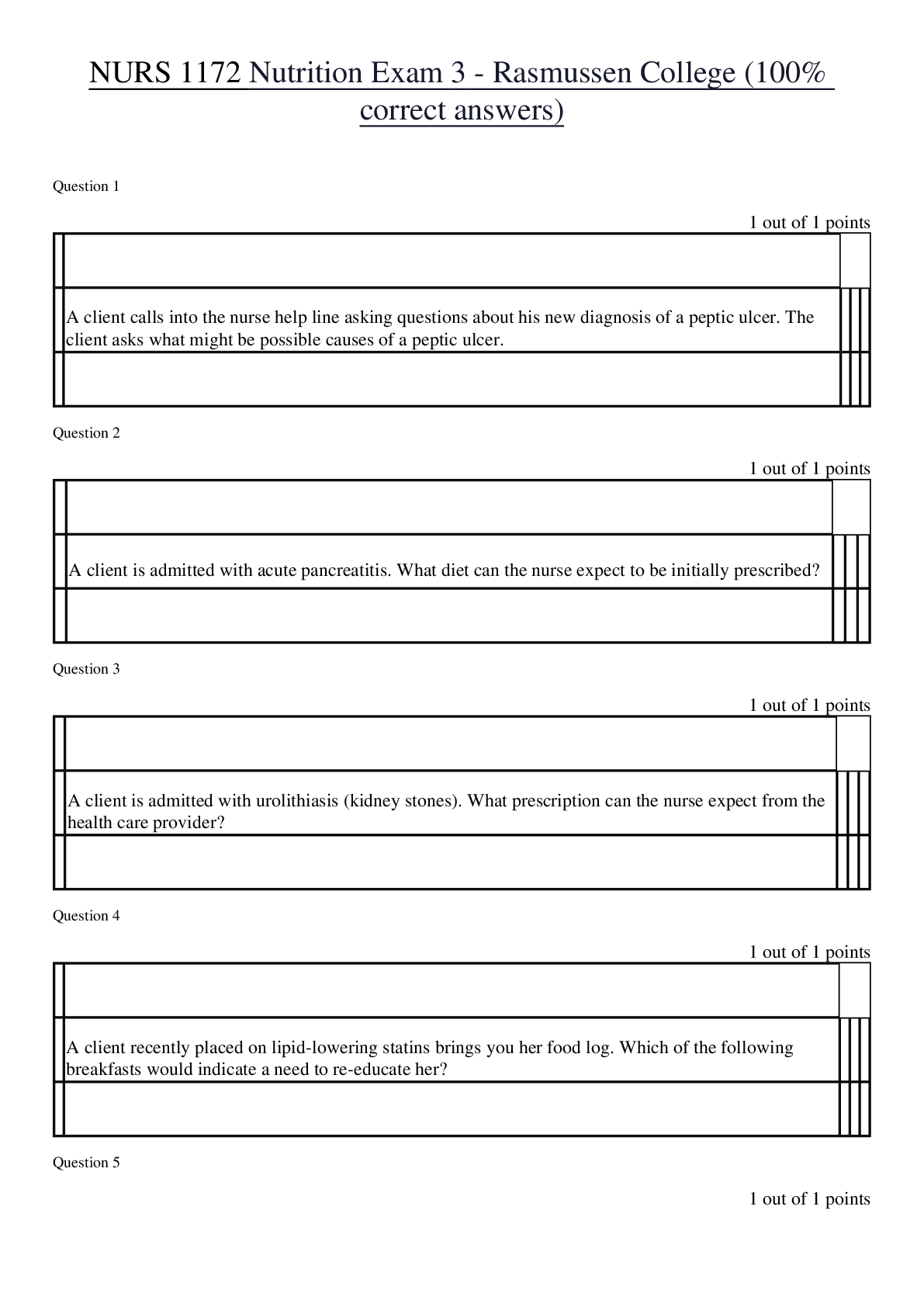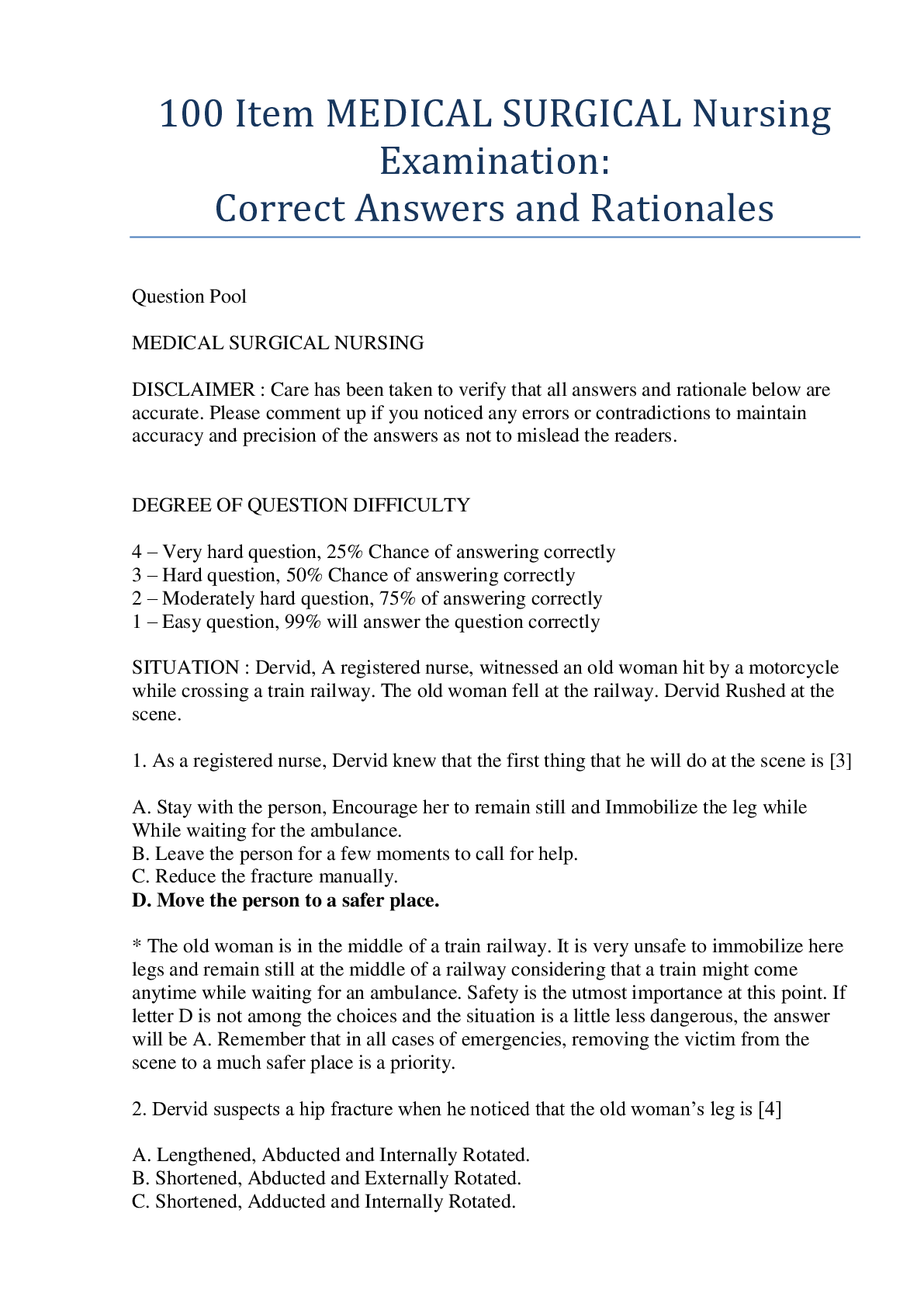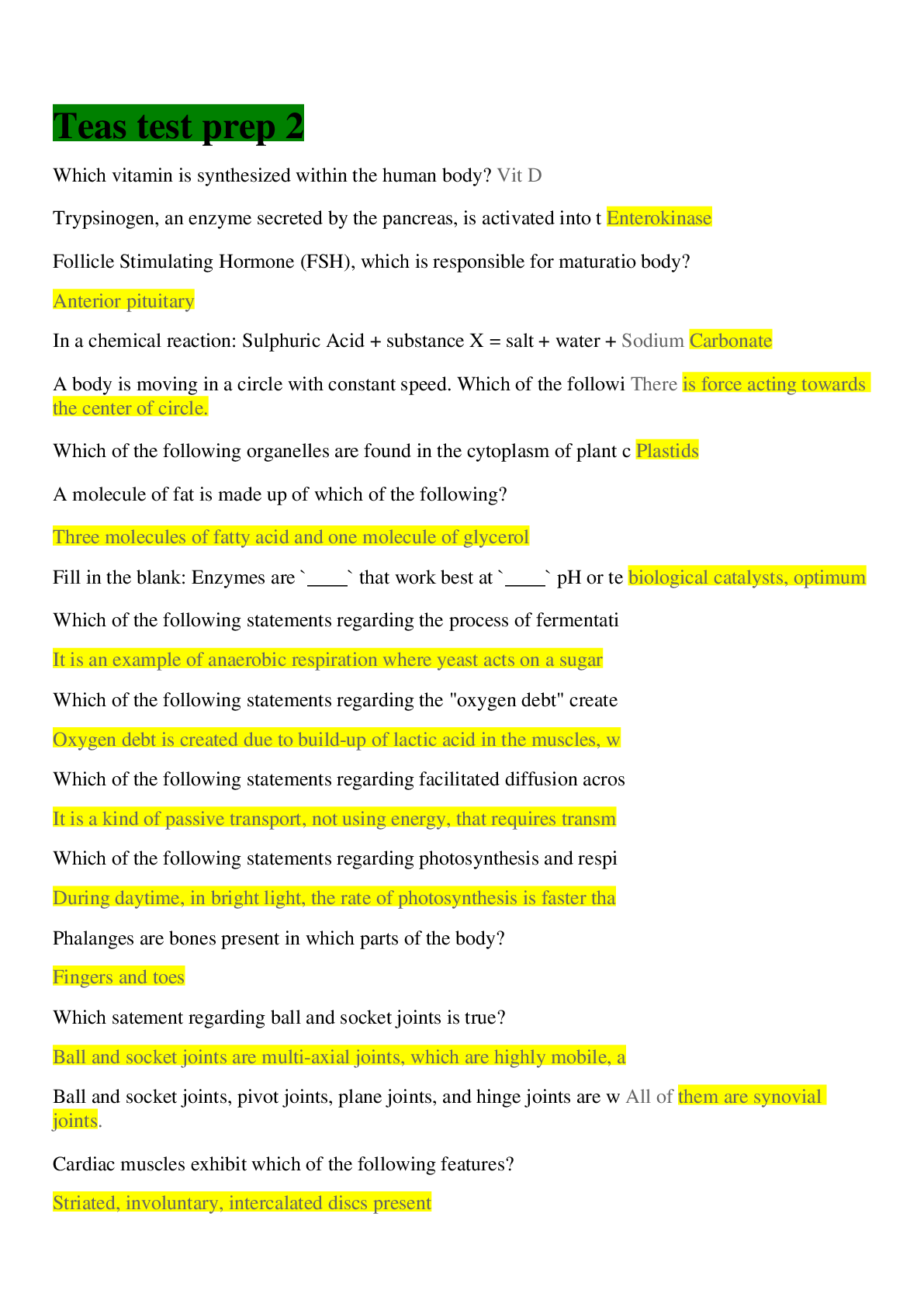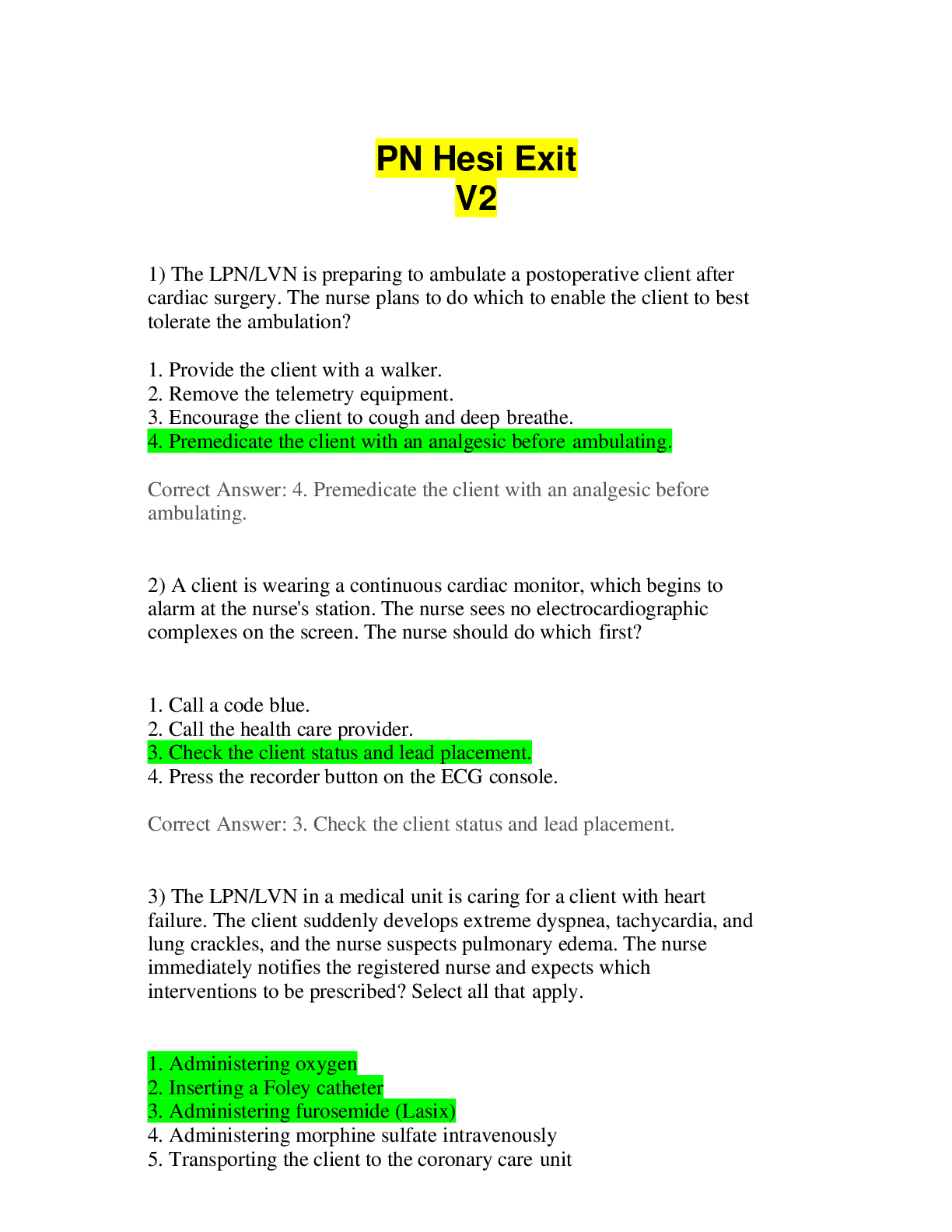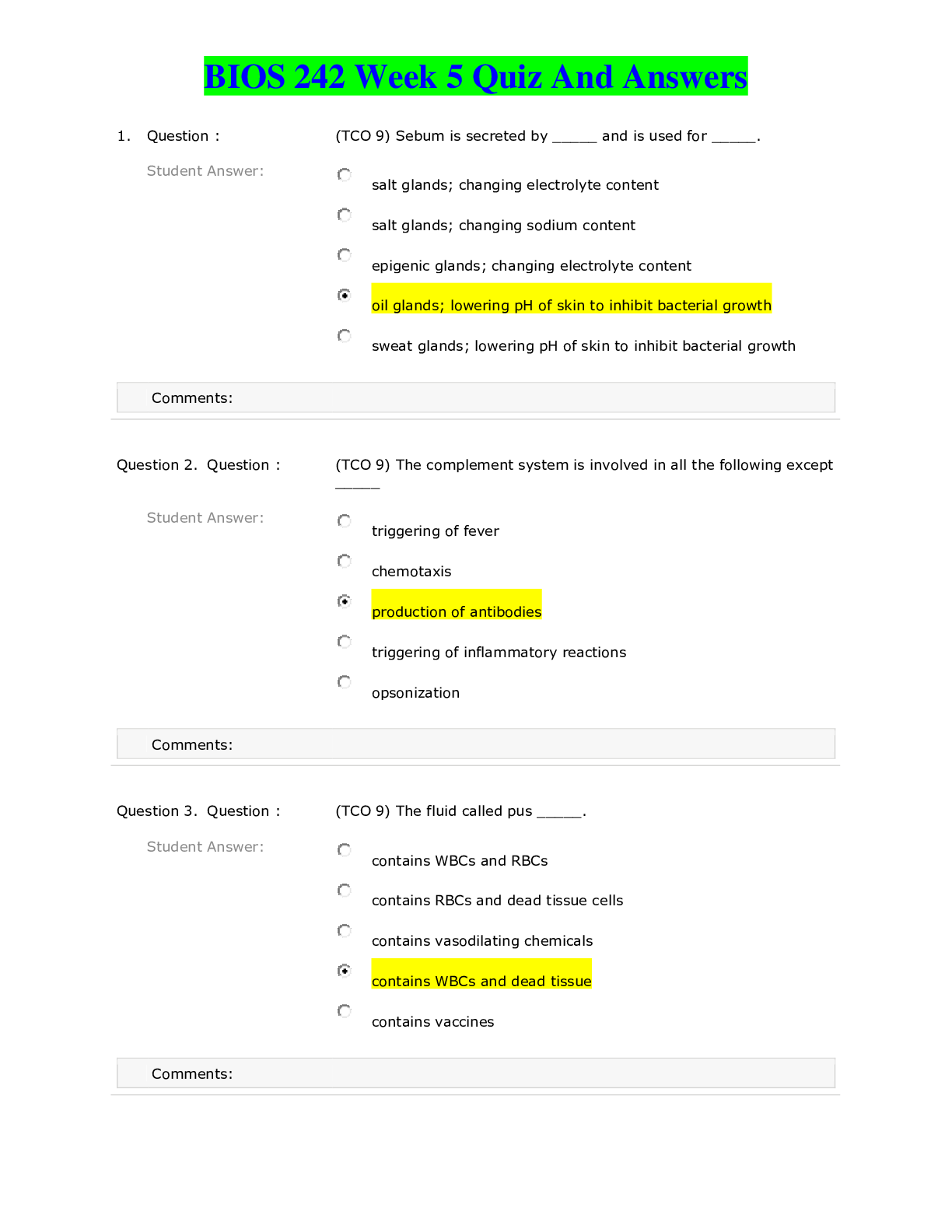Psychology > EXAM > OB 354 Midterm 1 Exam | Verified with 100% Correct Answers (All)
OB 354 Midterm 1 Exam | Verified with 100% Correct Answers
Document Content and Description Below
OB 354 Midterm 1 Exam | Verified with 100% Correct Answers What is organizational behavior (OB) - A branch of science - More specifically a field of study that seeks to understand and explain the b... ehaviors of individuals and groups in organizations using the steps of science. What are the four steps of science? 1. Observation 2. Explanation (theory) 3. Prediction (or association) 4. Control Define observation in the context of OB: - Job performance, organizational commitment, job motivation, and employee well-being Define explanation in the context of OB: - Employees are MORE motivated in their jobs when they are required to use a variety of skills rather than repetitive tasks Define prediction in the context of OB: - We can measure job motivation based on the variety of skills required. They are positively correlated Define control in the context of OB: - We can "control" job motivation across employees by increasing skill variety What is a theory? - A well-tested explanation for a broad set of observations What helps us test our theories for verification? - Correlation coefficients What is correlation? - The relationship between two variables (-1 < r < 1) What would be the correlation coefficient for PERFECT positive correlation? r = 1 What would be the correlation coefficient for moderately positive correlation? r = 0.5 What would be the correlation coefficient for NO correlation? r = 0 What is correlation unable to prove? - Causation/why things happen the way they do How can we prove causation? - Correlation - Temporal precedence - Elimination of alternative explanations What is job performance? - The value of the set of employee behaviors that contribute, either positively or negatively, to organizational goal accomplishment Why would it be problematic to set consequences to job performance? - It can be inaccurate to generalize an entire organizations behavior based on the negative behavior of a few employees - Can result in violation of policies within the organization - Consequences can't always be controlled - Managers may not be able to give feedback for improvement What are the three categories of behaviors that constitute overall job performance? - Task performance (positive) - Citizenship behavior (positive) - Counterproductive behavior (negative) What is task performance? - The behaviors involved in transforming organizational resources into the goods and services that an organization produces (ex. a flight attendant demonstrating safety procedures) What are the three aspects of task performance? - Routine task performance (ex. how to wear a seatbelt) - Adaptive task performance (ex. conducting emergency escape) - Creative task performance (designing new products) What is citizenship behavior? - Voluntary activities that may or may not be rewarded but that contribute to the organization by improving the quality of the setting where work occurs What is an example of "helping" in regard to citizenship behavior? - Assisting new coworkers with heavy workloads What is an example of "courtesy" in regard to citizenship behavior? - Keeping coworkers informed about matters that involve them What is an example of "sportsmanship" in regard to citizenship behavior? - Maintaining a positive attitude with coworkers, even if there is a situation What are the three aspects of organizational citizenship behavior (OCB-O)? - Voice - Civic virtue - Boosterism What is an example of "voice" in regard to organizational citizenship behavior (OCB-O)? - Speaking up and offering constructive suggestions to improve the organization What is an example of "civic virtue" in regard to organizational citizenship behavior (OCB-O)? - Participating in company operations at a deeper-than-normal level (ex. attending voluntary meetings) What is an example of "boosterism" in regard to organizational citizenship behavior (OCB-O)? - Representing the organization in a positive way What is counterproductive work behavior-organization (CWB-O)? - Behaviors that focus on REDUCING the efficiency of the organization and HARM the organization's property What are the two types of counterproductive work behavior-organization (CWB-O)? - Production deviance - Property deviance What is an example of "production deviance" in regard to counterproductive work behavior-organization (CWB-O)? - Wasting resources or substance abuse What is an example of "property deviance" in regard to counterproductive work behavior-organization (CWB-O)? - Sabotaging/stealing physical equipment What is counterproductive work behavior-individual (CWB-I)? - Behaviors that focus on INTENTIONALLY harming individuals within the organization What are the two types of counterproductive work behavior-individual (CWB-I)? - Political deviance - Personal aggression What is an example of "political deviance" in regard to counterproductive work behavior-organization (CWB-I)? - Gossiping about coworkers or talking in a rude manner What is an example of "personal aggression" in regard to counterproductive work behavior-organization (CWB-I)? - Harassing coworkers or physical abuse towards others What is the definition of PROSOCIAL counterproductive work behavior (CWB)? - Behaviors that may seem well-intentioned, but actually cause harm to individuals or the entire organization. What is an example of prosocial counterproductive work behavior? - A cashier at a pharmacy that doesn't charge low-income customers How are counterproductive work behaviors and organizational citizenship behavior CORRELATED? - Strongly negative correlation (r = -1) - If counterproductive work behavior DECREASES, organizational citizenship behavior INCREASES How are counterproductive work behaviors and task performance related? - Weak negative correlation (r = -0.5) What is the definition of organizational commitment? - The desire of an individual employee to remain as a member of the organization What is the definition of withdrawal behavior? - A set of actions that an employee may exhibit to avoid work situations (may lead to quitting their job) What are the three types of organizational commitment? - Affective commitment - Continuance - Normative What is affective commitment? - A desire to remain a part of the organization due to an emotional attachment What are the two social network theories and what do they suggest about employees that are likely to quit/leave organization - EROSION MODEL: Employees with less emotional bonds are more likely to quit - SOCIAL INFLUENCE MODEL: Employees who are closely linked to employees who are likely to leave will be more motivated to quit What is the definition of continuous commitment? - A desire to remain a part of an organization because there are costs associated with leaving/quitting What are the three factors that influence continuous commitment? - Employee's total amount of investment (ex. 3 years into university, might as well stay) - Lack of alternatives (ex. bad job market) - Embeddedness (ex. employee is too closely linked with the organization) What are the three facets of embeddedness? - Links ("I've worked here too long") - Fit ("I feel like my skills suit this job well, I like where I'm at) - Sacrifice ("I would be losing a lot if I quit now") What is the definition of normative commitment? - A desire to remain at an organization because you feel OBLIGATED to be there What are the two ways to influence normative commitment? - Create a feeling that employees are in debt to the organization (ex. pay off employee's debt/tuition) - Engage in charitable activities (ex. employees feel like their organization takes care of them) What is the definition of psychological withdrawal? - Mental detachment from job responsibilities (ex. daydreaming, socializing, scrolling through the internet) What is the definition of physical withdrawal? - Behavioral detachment from job responsibilities (ex. being tardy, missing meetings, taking long breaks) What is the definition of job satisfaction? - A pleasurable or positive emotional state resulting from the appraisal of one's job or job experience What is the main proposition (i.e., what the theory proposes/suggests) of the value-percept theory? - Job satisfaction depends on whether you perceive that your job supplies the things that you VALUE What is the equation of value fulfillment? - Dissatisfaction = (V(want) - V(have)) * V(importance) What is the meaning of "person-environment fit"? - The fit between what you desire and what can be provided for you What does Taylor's scientific management concentrate on? - How to increase the efficiency of employees by making job tasks more simplified and specialized [Show More]
Last updated: 9 months ago
Preview 3 out of 10 pages

Loading document previews ...
Buy this document to get the full access instantly
Instant Download Access after purchase
Buy NowInstant download
We Accept:

Reviews( 0 )
$12.00
Can't find what you want? Try our AI powered Search
Document information
Connected school, study & course
About the document
Uploaded On
Oct 13, 2024
Number of pages
10
Written in
Additional information
This document has been written for:
Uploaded
Oct 13, 2024
Downloads
0
Views
42

